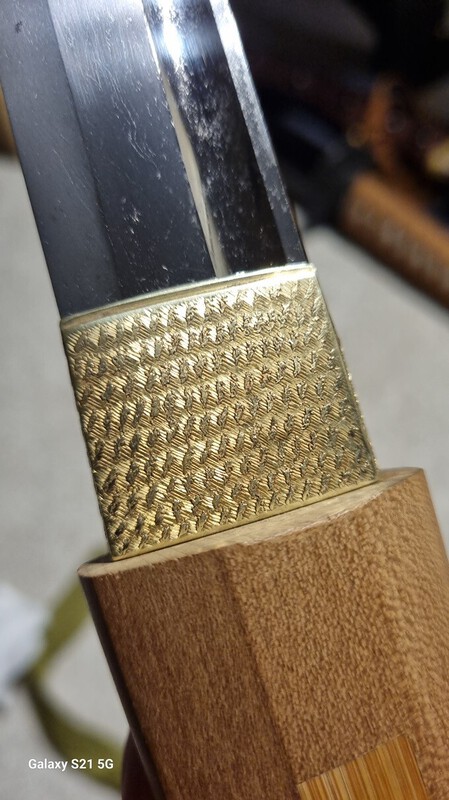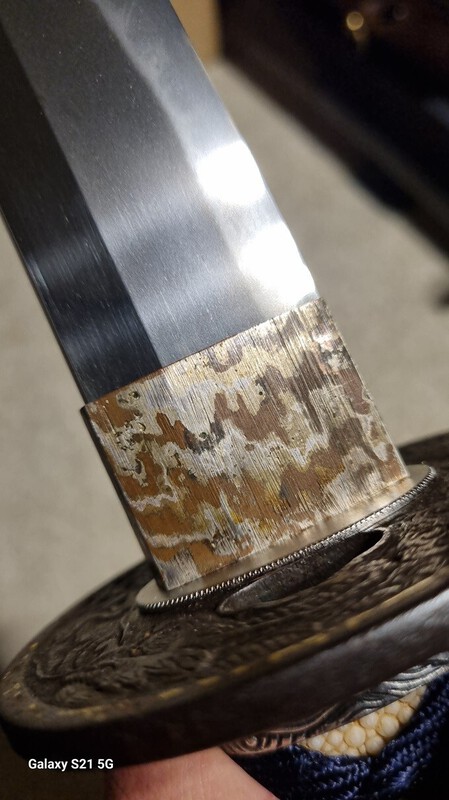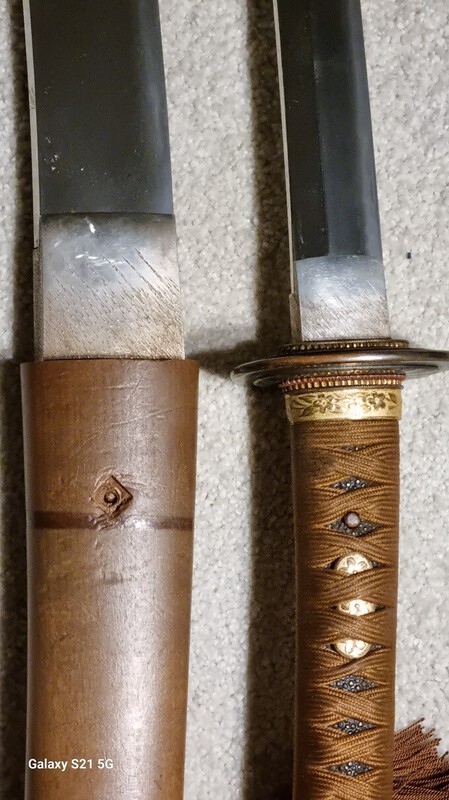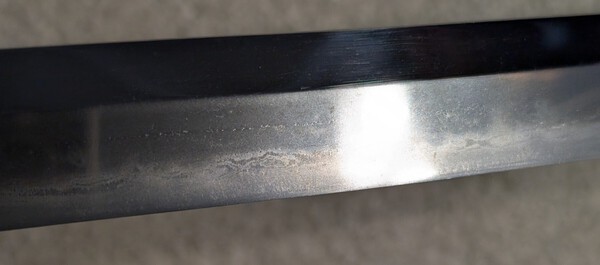
Gerry
Members-
Posts
165 -
Joined
-
Last visited
Content Type
Profiles
Forums
Events
Store
Downloads
Gallery
Everything posted by Gerry
-
Nice looking blade, and it looks like a wakizashi, since the torokusho states the cutting edge being 5?.8cm. The mounts are very nice, especially that area of the ray skin that looks like a chrysanthemum flower. This is probably a sword that came from a collector in Japan, judging from the attached torokusho. BTW, the tang is ubu, not osuriage.
-
Here's horimono that you don't see everyday...a katakiriha wakizashi with some sort of plant motif horimono the hirazukuri omote side. https://www.jauce.com/auction/h1180089848?allow=1
-
Minamoto Yoshichika with colonel tassel
Gerry posted a topic in Auctions and Online Sales or Sellers
https://www.jauce.com/auction/h1178916285 Seems like gunto can be quite popular even in Japan, given the final selling price of 665K yen for this Yoshichika. I thought the frayed tsukamaki might turn some buyers off, but I guess the colonel's tassel and double ashi saya made up for it. -
Early Endo Mitsuoki shobu zukuri katana
Gerry posted a topic in Auctions and Online Sales or Sellers
https://www.jauce.com/auction/m1176613035 Here's another oddity on Yahoo Japan, a very early (1931) shobu zukuri katana by Endo Mitsuoki, when he was probably still honing his skills as a self taught swordmith.. The torokusho is from Showa 37, so it's probably too early to be a gimei Mitsuoki blade. It looks pretty rough, with a big ware on the mune, and the mei oddly has Kunimune inscribed on it too, so not sure if Mitsuoki was going for a copy of a Kunimune shobu zukuri katana. It ultimately went for a steal. -
This listing for a koto nagamaki was quite interesting. https://www.jauce.com/auction/b1177089370 It looks like a beefy shobu zukuri ubu blade, with a very thin suguha hamon. The jigane seems a little odd with patches of what looks like core steel, but when I inquired with the seller about the weight of the blade only, he said it was 1,312g, which is pretty heavy. It didn't go for too high of a price eventually.
-
Intermediaries for Japanese auction biddings?
Gerry replied to JeanEB's topic in Auctions and Online Sales or Sellers
It's pretty easy signing up for Jauce. -
Interesting Section of a Nakago
Gerry replied to Infinite_Wisdumb's topic in General Nihonto Related Discussion
It ultimately went for 3.6M yen...I guess some people must really like long swords. -
Ha ha...ah, seeing the feedback left on the other thread, I'm not the only one seeing red flags for this auction.
-
https://www.jauce.com/auction/h1174332059 This odachi is getting a fair amount of bids. Swords of this length don't show up too often on Yahoo Japan, but the nakago oxidation and pitting looks a little off to me. What do you all think?
-
This has always been a question I ask myself especially when I'm looking at gendai blades that I really like. It's always a conundrum to me when I purchase non-papered gendai blades, because there's a very likely chance that the price will go down when I try to sell them, even for non-papered Mukansa level blades.
-
Oh, I didn't realize that there was a habaki thread, and I'll make sure to post it there too.
-
The mantis is such a recurring motif in tosogu.
-
I've always seen that good blades are usually accompanied with nice habaki, and not usually the other way around, so I put good value in nice custom habaki. Most of my swords have the standard cat-scratch textured habaki, but I thought I'd share a few with more unique designs. I particularly like this one with the dragon detail. And this one on the left is just a massive regular habaki, compared to a similar one next to it on a 26.5" kai gunto.
-
-
I have a Shigemasa kai gunto made in 1940 that has a bizen choji hamon with a midare komi boshi on the omote side, and a gunome hamon with a komaru boshi on the ura side.
-
Aoi Art actually had a reasonably priced Morioka Miyaguchi daisho (900,000 yen) that I was almost going to buy back in Nov last year. I went down to the store, viewed the blades, and spoke to Tsurata-san about getting the daisho certified as such with NBTHK papers. He confirmed that as long as a katana and wakizashi were of the same smith with matching mei and nenki, NBTHK would paper them together on the same certificate. I went ahead and reserved the daisho, and was preparing payment when Aoi realized that Mr. Miyaguchi was still alive at 92 years old, and was still taking commissions for swords! So I couldn't get the daisho papered, and didn't proceed with the purchase. Therefore, it's apparently reasonably easy to get daisho NBTHK papers if you meet the conditions stated above, but you don't really see pre-shinshinto blades made as daisho.
-
It's odd that another soshou mei Shigetsugu on Aoi Art's website sold for much less in 2022, with a nicer hamon and papers too. https://sword-auction.com/en/product/10012/as21733-刀:笠間一貫斎繁継作/ I guess the winning bidder in today's auction really wanted the sword.
-
Ah, my apologies...from the numerous comments I've seen on this forum, I've always assumed that pretty much all the serious collectors here abhor "Fleabay", but I guess not. And is there really any chance of quietly bidding on anything on eBay nowadays, ha ha.
-
The "tsugu" character looks like little different from the regaulr soshou-mei, and there's also an additional description at the top right of the mei.
-
There's a listing for a soshou-mei Shigetsugu made in 1937 at the moment, and it's the first one I've seen with a mostly suguha hamon: https://www.ebay.com/itm/396194115902 Let's see how much it will eventually go for, despite the seller having no idea of the mei and nenki.
-
Samurai shokai actually has 2 gendaito kogarasu marus for sale if you're considering modern pieces.
-
I'm in the same mind of thought as you...as with anything to do with art, the item has to elicit an emotional pull. All the swords I've purchased have had to excite me on an emotional level above anything else, so that I get a sense of enjoyment whenever I hold the sword.
-
This topic also brings up another question I have. With the hobby of appreciating nihonto, how much of the value and perceived quality of a blade is due to subjective vs objective reasons? For example, with my limited knowledge, objectively, collectors look at the tightness and color of the jigane, the activity in the hamon, the physical balance of the blade, no kizu/ware, etc. However, there are subjective aspects also, such as the sori, the pattern of the jigane, the overall shape of the blade, the hamon style, etc. Do seasoned collectors generally agree on the combination of subjective and objective aspects of a blade to determine its value? Or do they have quite varying degrees of preference? I guess that's where the papers come in, to give a consistency in the appraisal of a blade.
-
Thanks for all the insightful replies, and once again, the breadth of knowledge on this forum is amazing.


















